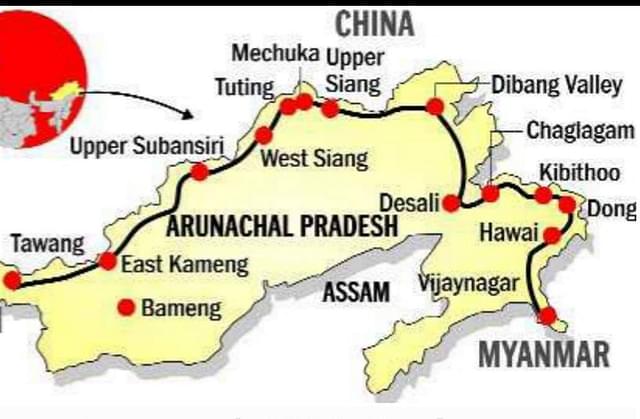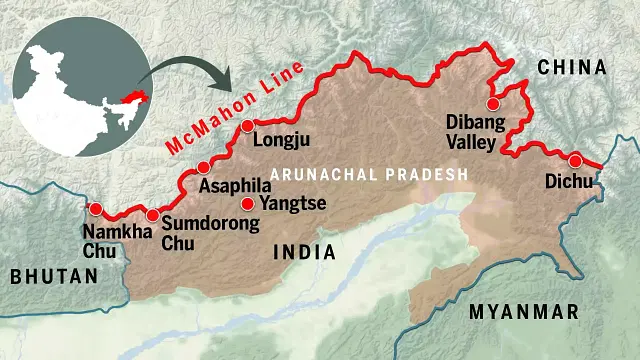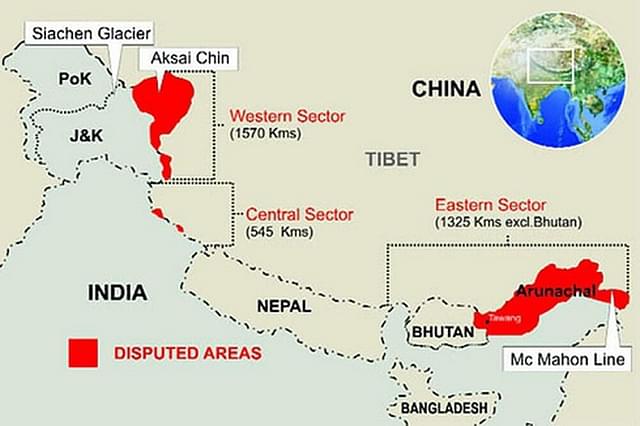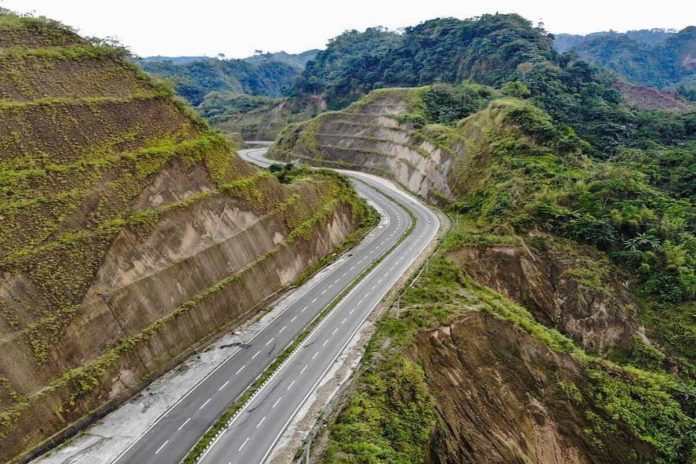The Arunachal Pradesh government has embarked on a major infrastructure project aimed at constructing a road running along the “India-Tibet-China-Myanmar” border, connecting some of the remotest parts of the state.
This road, known as the Frontier Highway, will be situated as close as 20 km from the Line of Actual Control (LAC) and international borders.
The Frontier Highway will stretch a total length of 1,500 km, with an additional 1,000 km of roads planned to further enhance connectivity in the region.
The entire project is estimated to cost around Rs 40,000 crore. It is seen as “one of India’s biggest and toughest” road construction projects.
The road will establish crucial connections to several significant locations, including Tawang, Mago Upper Subansiri, Upper Siang, Mechuka, Tuting, Dibang Valley, Kibithoo, Changlang, and Dong.
The project is currently being executed through a collaborative effort involving multiple agencies working closely together. These agencies include the Border Roads Organisation (BRO), the Ministry of Road Transport and Highways (MoRTH), and various other relevant organisations.
The Ministry of Road Transport and Highways (MoRTH) has announced that all necessary approvals and land acquisition processes will be carried out in a progressive manner, with a targeted completion date of March 2025.
Construction activities will also be executed in overlapping phases, aiming for a gradual completion by March 2027.
According to the plan, the road will also link up with the under-construction Trans-Arunachal Highway. This two-way national highway adheres to standard trunk route specifications.
It connects Tawang in the northwestern corner of Arunachal Pradesh to Kanubari in the southeastern part of the state, ultimately terminating at NH-52 near Akajan, in proximity to the Bogibeel Bridge near Dibrugarh, Assam.
With this project, Arunachal Pradesh will have three national highways — the Frontier Highway, the East-West Industrial Corridor Highway, and the Trans-Arunachal Highway.
In an effort to enhance connectivity, the Ministry of Road Transport and Highways (MoRTH) has identified six interconnectivity corridors with the aim of linking National Highway-15 in Assam to both the Trans Arunachal Highway (NH-13) and the proposed Frontier Highway (NH-913).

In 2014, Law Minister Kiren Rijiju championed the project while serving as the Minister of State for Home and overseeing border affairs.
During that same year, the Home Ministry initiated the project by requesting the Ministry of Road Transport and Highways (MoRTH) to prepare a comprehensive project report.
China had expressed objections to the project back in 2014, upon learning that it had received preliminary approval from the Prime Minister’s Office.
Chinese Foreign Ministry spokesman Hong Lei remarked at the time, “Until the border issue is resolved, we urge the Indian side to refrain from taking any actions that could further complicate the situation, in order to maintain the current state of peace and stability in the border region.”
Speaking about the proposed highway, Khandu earlier stated that, “1962 was history and will never be repeated ever. In 1962, the scenario was very different. Infrastructure in the region was very poor. Despite that the Indian Army fought bravely and sacrificed thousands of lives to protect the motherland. But today, we are not what we were in 1962.”
Significance of the Frontier Highway project
The significance of the Frontier Highway project is multifaceted. Once completed, it will have substantial strategic value by improving access to border areas. Moreover, it will revolutionise road connectivity within the state, mitigating migration from these border regions and fostering development in remote villages.
“The frontier highway has a huge strategic value. It will bring transformational changes in road connectivity in Arunachal Pradesh. This will be beneficial for the Army too,” Chief Minister Pema Khandu told PTI.
Chief Minister also earlier said that the road would help in “safeguarding Indo-China-Myanmar border” and “control migration from border areas.”
This prestigious project by the state government will also link with the Trans-Arunachal Highway, a 1,811-km-long highway under construction, which connects Tawang in the northwest to Kanubari in the southeast and links up with National Highway (NH)-52 near Akajan, close to the Bogibeel bridge near Dibrugarh in Assam, adjacent to Yangtse.
Both the Frontier Highway and the Trans-Arunachal Highway will be beneficial not only for the military, ensuring seamless movement of armed forces and equipment to the border areas, but also for the common populace, by significantly improving accessibility and infrastructure in the region.
Line of Actual Control (LAC)
The LAC is the demarcation that separates Indian-controlled territory from Chinese-controlled territory. It is divided into three main sectors:
- Eastern Sector: This sector spans Arunachal Pradesh and Sikkim.
- Middle Sector: It covers areas in Uttarakhand and Himachal Pradesh.
- Western Sector: This sector is primarily in Ladakh.
It’s important to note that there is a discrepancy in the perception of the LAC’s length:
- India considers the LAC to be approximately 3,488 kilometers long.
- China, on the other hand, asserts that the LAC is only around 2,000 kilometers long.
India’s line, also known as the official boundary marked on maps by the Survey of India, encompasses both Aksai Chin and Gilgit-Baltistan. This means that the LAC does not align with India’s official claim line.
In China’s case, the LAC generally represents its claim line, except in the eastern sector where it claims the entire state of Arunachal Pradesh as South Tibet. These differing interpretations of the LAC and the territorial claims have been a source of tension and disputes between India and China.


India’s Infrastructure Drive in Northeast
The development comes at a time when China has built over 600 border defense villages along the frontier with India in Tibet. Some of these villages have come up in Indian territory under Chinese occupation.
Faced with an aggressive China, India has undertaken a big infrastructure drive in the Northeast, with a particular emphasis on Arunachal Pradesh and Sikkim, accelerating work on a number of bridges capable of transporting heavy equipment to tunnels, highways, and feeder roads all the way up to the LAC.
Numerous specialised and cutting-edge road and tunnelling equipment have been introduced, with a concerted endeavour to keep pace with the rapid infrastructure development undertaken by the Chinese on their side.
Apart from the Frontier Highway, the Centre has also approved funding of Rs 15,720 crore for the inter-connectivity corridors project.
In an effort to keep up with the Chinese’s rapid infrastructure development, a significant amount of specialised road and state-of-art tunnelling equipment is being deployed.
The Centre is implementing various rail, road and air connectivity projects worth Rs 1,34,200 crore in Northeast India.
Finance Minister earlier said the Centre was spending over Rs 74,000 crore for 20 railway projects covering a length of 2,011 km.
The Centre is developing 4,000 km of roads in the region at a total cost of Rs 58,000 crore, she added.
Fifteen projects for air connectivity involving an expenditure of Rs 2,200 crore are also ongoing in the region, she added.
China’s Infrastructure Buildup Opposite Arunachal
The 1,600-km-long Sichuan-Tibet rail line will link Lhasa on the Tibetan Plateau with Chengdu in central Sichuan. In June 2021, China had opened the 435-km-long section of the line between Lhasa and Nyingchi.
Nyingchi, a town opposite India’s Tuting sector, in the Upper Siang district of Arunachal, is only 40 km away from the border. The Nyingchi-Lhasa rail line itself runs much closer to the border than that at some points.
The 52nd and 53rd Mountain Infantry Brigades of the Chinese Communist Party (CCP)’s People’s Liberation Army (PLA) are based in the larger Nyingchi prefecture.
China has also built a 250-km-long highway linking Nyingchi with Lhasa, which, like the Lhasa-Nyingchi rail line, runs close to Arunachal.
Construction of the Lhasa-Nyingchi rail line, nearly 75 per cent of which is either over bridges or under tunnels, began in 2015, and track laying was completed over five years, in December 2020, at a cost of $4.8 billion.
The remaining 1,100-km long section of the line, a part (Chengdu-Ya’an section) of which is already complete, is expected to be ready by 2030.
The headquarters of China’s Western Theatre Command, which is responsible for the frontier with India from Arunachal to Ladakh, is located in Chengdu.
The Lhasa-Nyingchi rail line project has received consistent attention from the top echelons of the CCP in the past, including President Xi Jinping himself, who linked it to ‘border stability’ as recently as November 2020, during the standoff with India in Ladakh.
Although the Chinese state media links the Sichuan-Tibet rail line project to economic development in Tibet, the CCP apparat has pointed out that it will act as a “fast track” for the “delivery of strategic materials” to Tibet “if a scenario of a crisis happens at the border”.
During his visit to Tibet in July 2021, the Chinese President Xi visited the Nyingchi railway station to inspect the Sichuan-Tibet railway line, and then took a train to Lhasa.
Xi’s inspection of the project, in the middle of a tense border standoff with India, has brought the focus back on this aspect of infrastructure development in Tibet.
The construction of rail lines and highways on the Tibetan Plateau line will not only ease the movement of troops within China’s Western Theatre Command but also enable the PLA to bring trainloads of troops and equipment from other theatres in a very short time, a scenario that can’t be ruled out after China’s massive mobilisation along LAC in eastern Ladakh in 2020.


